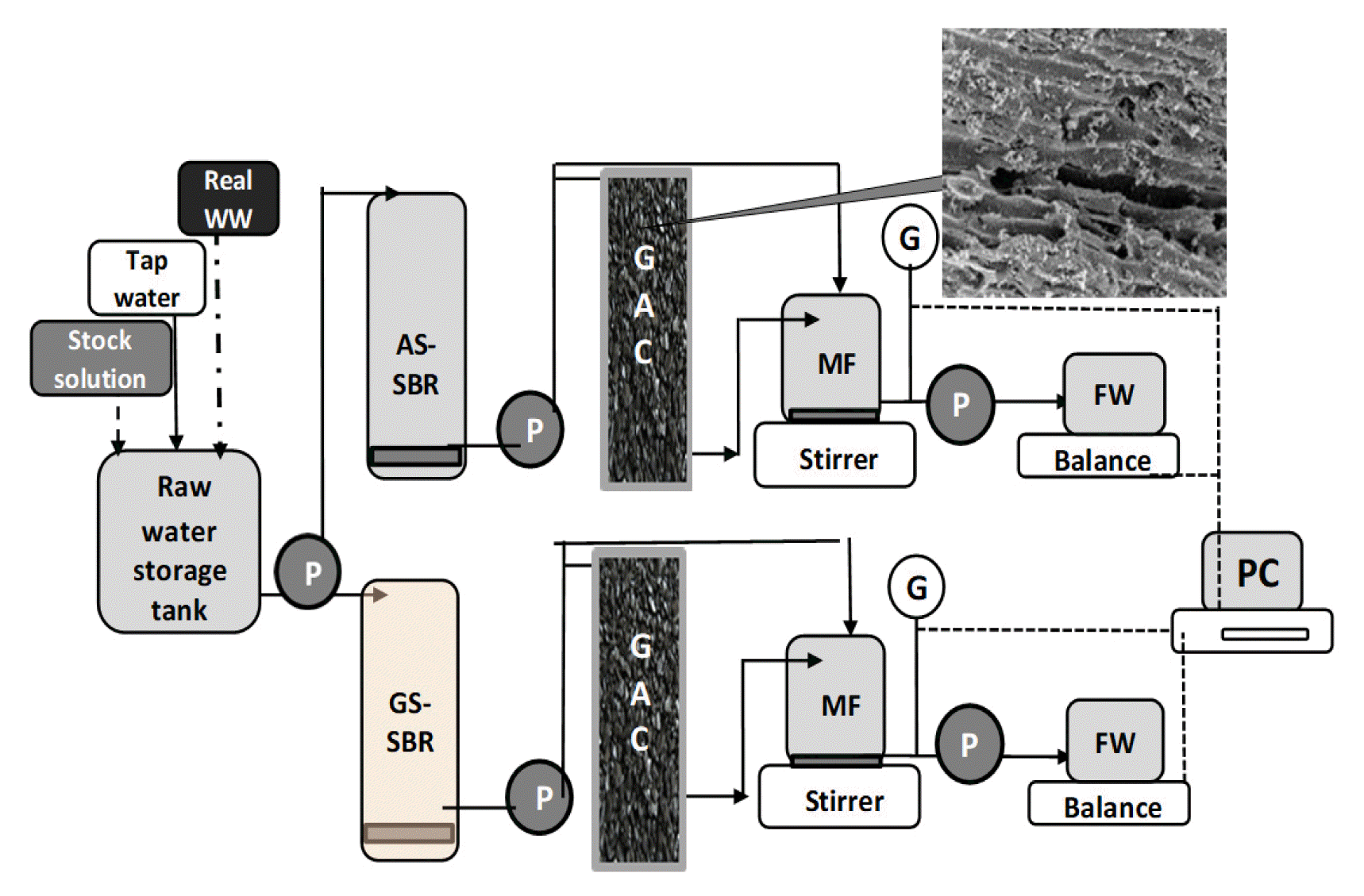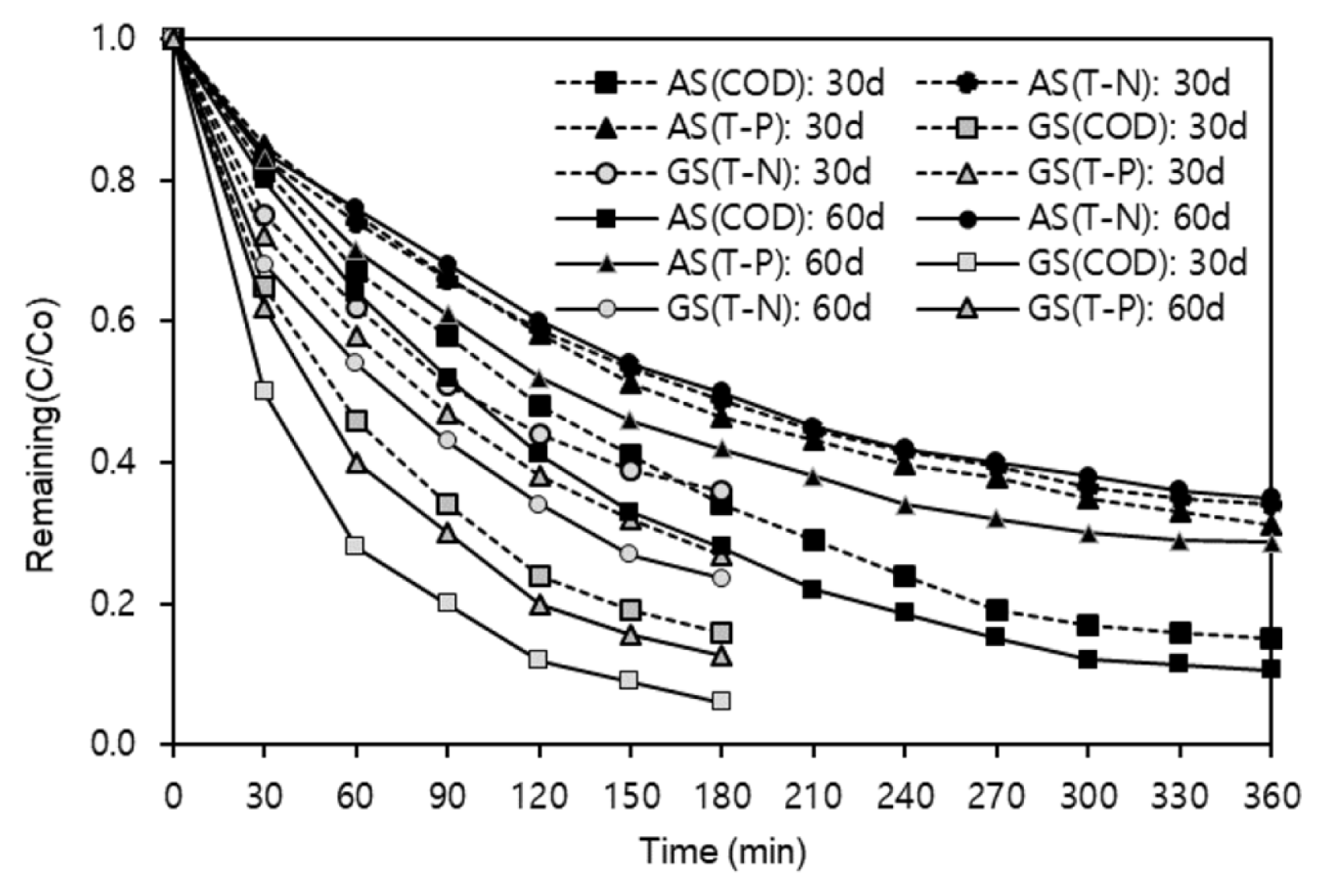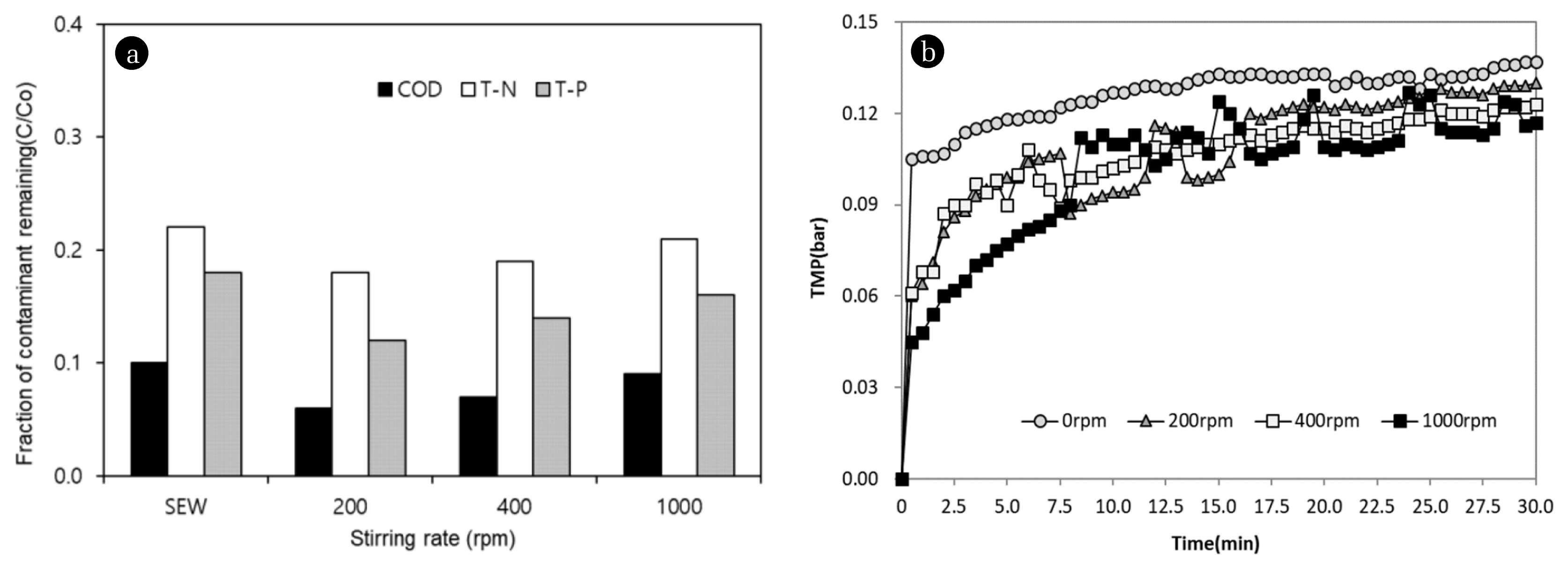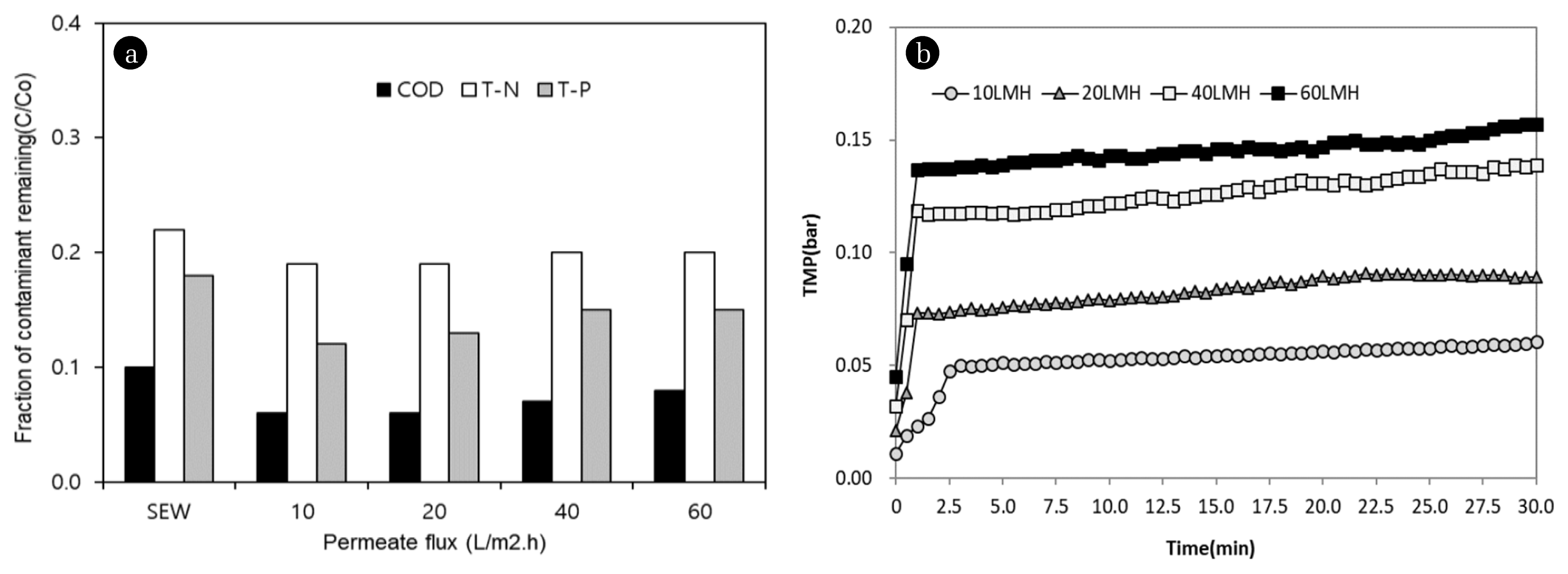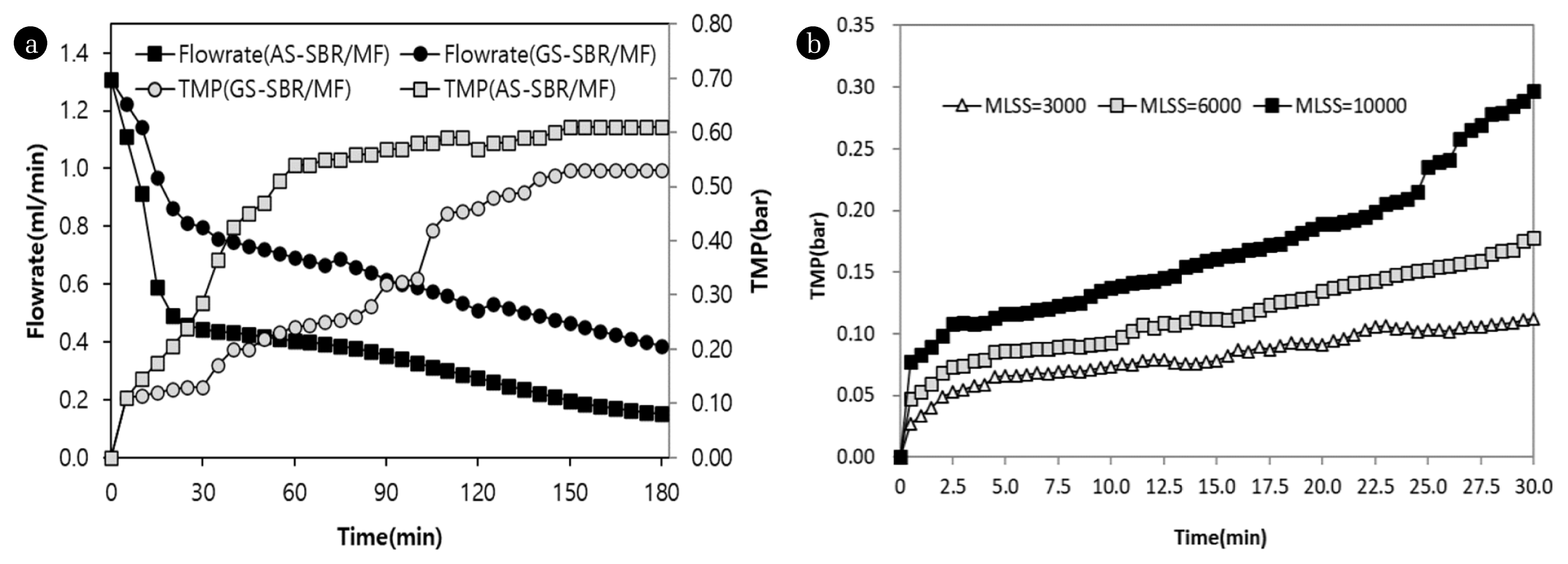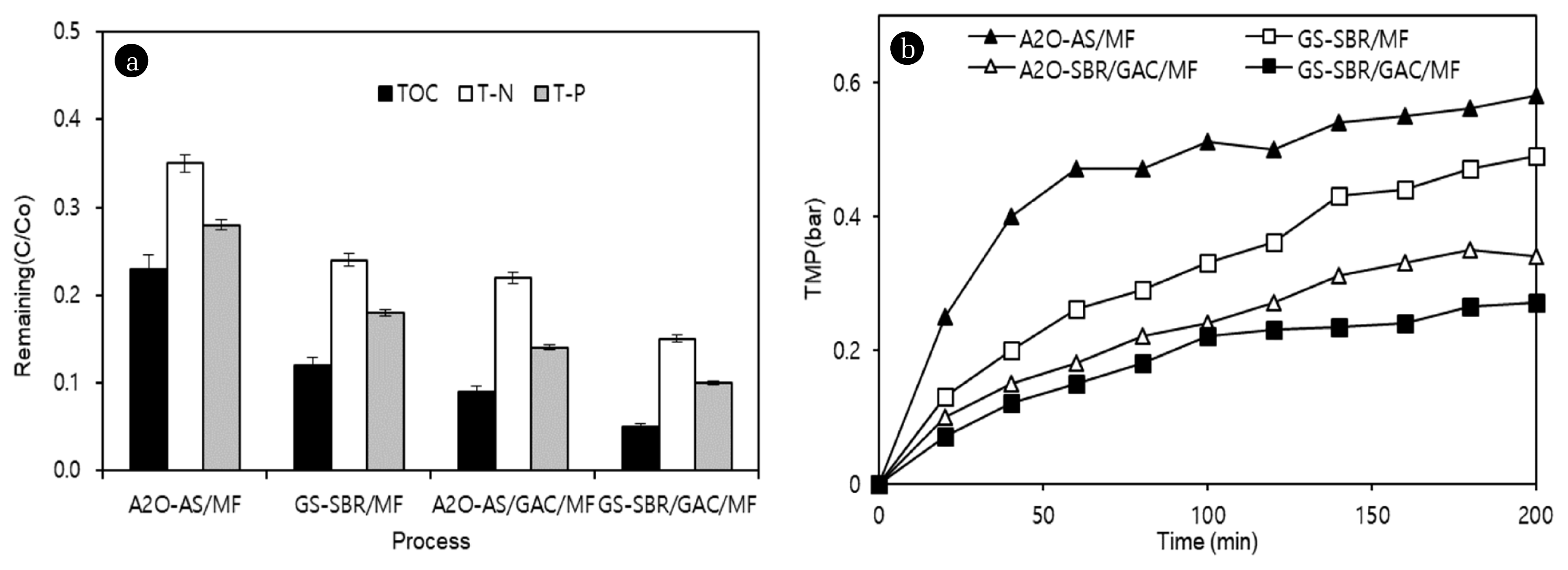1. Introduction
Regarding stable operation and a stringent effluent guideline, an activated sludge (AS) process coupled with a membrane in rural areas has been upgraded to treat a mixed wastewater effectively. Three kinds of the mixed wastewater generated on the rural area can be identified: domestic wastewater (DW), black water (BLW: feces and urine), and landfill leachate (LL), which have high organics and nutrient concentrations with nonbiodegradable and heavy metal components [1, 2]. A higher quality of the effluent from membrane bioreactors (MBRs) treating the mixed wastewater has been often difficult to obtain effectively through the AS process. The MBR using AS has resulted in a rapid decline of permeate flux, which results in a reduction in productivity of the MBR and increase in maintenance and operational costs [3]. Various approaches have been employed to mitigate membrane fouling including inorganic flocculants and granular materials addition [4–5].
Therefore, a conventional bioreactor needs to be a high-rate reactor through an increase in the biomass level, such as biogranulation and particle-supported biofilm. A MBR using granular sludge (GS) has been developed to overcome the challenges of a higher-quality effluent and membrane fouling in conventional MBRs [6]. Compared with the AS, a round GS is compact and strong in structure with the ability to settle rapidly and a high capacity for biomass retention [7]. A sequencing batch reactor (SBR) technology using GS as a pretreatment for membrane filtration (MF) is under development to enhance the performance of simultaneous organics and nutrient removal and to mitigate membrane fouling in conventional MBRs [8]. The other alternative pretreatment seems to be a granular activated carbon (GAC) filter, which provides both adsorption and biofiltration through biological activated carbon (BAC). BAC has two functions of biodegradability and filtration due to the growth and formation of a layer of biomass (biofilm) on the rough porous surfaces of GAC particles [9]. The BAC bed also has the advantage of being a compact reactor due to a high biofilm surface area, high biomass concentration, and minimum excess sludge production, resulting in stable operation and good protection against toxicants. The BAC utilizing the combination of adsorption and biodegradable techniques also provides an attractive pre-filtration for achieving both high organics removal and low membrane fouling rates [9, 10]. Previous studies reported that the submerged type of membrane module into a GS reactor and the addition of activated carbon into MBRs have been studied to improve both a membrane fouling mitigation and an organic and nutrient removal [6–10]. The submerged MBRs have achieved a low fouling rate for short filtration time, whereas they have achieved a high fouling rate for a long filtration time, resulting in a high increase of suspended solids through granules break-up due to an agitation in MBR [11, 12]. In this study, hybrid systems combining GS with and without GAC bed followed by a membrane were configured to remove an effective potential foulants regarding a long filtration time and a low fouling rate [13–16]. Thus, The purposes of this study are to deduce the appropriate operating conditions of AS and GS-SBR coupled with a membrane using synthetic wastewater and to assess both the potential for reclamation and reuse of real mixed wastewater and the feasibility of mitigating membrane fouling by the AS- and GS-SBR/GAC as a pretreatment of MF.
2. Material and Methods
2.1. Experimental Apparatus and Materials
The bench- and pilot-scale plants for this study consisted of four systems: AS-SBR/MF, GS-SBR/MF, AS-SBR/GAC/MF, and GS-SBR/GAC/MF. The plants for this research (Fig. 1) consisted of a raw wastewater storage tank, two SBRs for AS and GS reactors (each hydraulic retention time (HRT) < 6 h), two GAC beds, two MF reactors, and an effluent storage tank. The SBR and GAC beds were fabricated using four transparent acrylic cylinders. Air diffusers were placed at the bottoms of the SBR for aeration and the GAC beds for backwashing. The SBRs (total volume: 2 L, working volume: 1 L) were operated by means of an AS and a GS concept. A complete cycle of the SBR operation comprised filling (5 min), aeration/non-aeration (100–240 min/60–90 min), settling (10–30 min), and discharging (5 min) steps. Influent was added from the top of the reactor, and air was introduced from the bottom at an air flowrate of 2–4 L/min. Membrane filtration experiments were carried out to input mixed liquors taken from AS-SBR and GS-SBR processes into membrane filters. For biofiltration experiments to reduce the residual contaminants in the effluent from SBRs, the GAC bed (working volume: 2 L, diameter: 5 cm, height: 120 cm) was packed up to 60 cm with GAC media (effective size: 1.5 mm; Samchully, Korea). The empty bed contact time (EBCT) of the GAC bed ranged from 0.6 to 1.2 h. The MF process using a dead-end stirred filtration (DSF) cell (Amicon 8400, Millipore, USA) consisted of raw water and effluent storage tanks, an electric balance, a digital pressure gauge, a computer, and a cylindrical vessel (working volume: 200 mL) equipped with a porous support on which the membrane had been placed [17]. Flat sheet membranes (polyvinylidene di-fluoride, PVDF) with a pore size of 0.22 μm and surface area of 41.8 cm2 were used, and a new membrane was used for each filtration run. Stirring rates of 200–1,000 rpm were selected to determine the effect of the agitation rate on membrane fouling by sludge components. The permeate weight was measured during the filtration process with an electronic balance. The sampling-time interval was varied from 30 s to 5 min according to the permeation rate. The effluent flow and transmembrane pressure (TMP) were monitored with an electric balance and a digital pressure gauge, respectively. Data on the permeate mass and pressure were collected every minute, and the results were stored on a computer.
2.2. Influent Characteristics and Analyses
Synthetic and real wastewaters as raw water were used during this experiment. The influent qualities of synthetic wastewater used for AS- and GS-SBR experiments were as follows: water temperature 20 ± 0.5°C, pH 6.7 ± 0.4, chemical oxygen demand (COD) 300 ± 10.5 mg/L, total nitrogen (T-N) 17.43 ± 1.56 mg/L, and total phosphorus (T-P) 3.25 ± 0.18 mg/L. The synthetic wastewater was composed of 150–350 mg/L of glucose (Daejung, Korea), 80 mg/L of magnesium sulfate heptahydrate (MgSO4, 7H2O; Samchun, Korea), 70 mg/L of ammonium chloride (NH4Cl; Daejung, Korea), 20 mg/L of potassium dihydrogen phosphate (KH2PO4; Yakuri, Japan). The additional compositions for GS-SBR were 150 mg/L of sodium acetate(CH3COONa, Oriental, Korea) and 1.0 ml/L of trace element solution: (20 mg/L of ferrous sulfate heptahydrate (FeSO4, 7H2O; Daejung, Korea), 50 mg/L of copper sulfate pentahydrate (CuSO4, 5H2O; Oriental, Korea), 3 mg/L of boric acid (H3BO3; Oriental, Korea), 50 mg/L of manganese sulfate monohydrate (MnSO4, H2O; Yakuri, Japan), 80 mg/L of zinc chloride heptahydrate (ZnCl2, 7H2O; Daejung, Korea), 50 mg/L of cobalt (II) dichloride hexahydrate (CoCl2, 6H2O; Sanchun, Korea)). A stock solution was diluted with tap water. The bioreactor and bed were initially inoculated with AS obtained from the aeration tank of a real sewage treatment plant. Initial concentration of mixed liquor suspended solid (MLSS) in both reactors was 500 ± 50 mg/L. The characteristics of real mixed wastewater (DW 67.0%: BLW 25.5%: LL 7.5%) were as follows: water temperature: 22.6 ± 1.8°C, pH: 6.8 ± 0.5, 134.8 ± 3.5 mg TOC/L, 32.00 ± 1.60 mg T-N/L, 3.40 ± 0.13 mg T-P/L, and 42.5 ± 8.4 mg SS/L. This wastewater was pre-treated by means of gravity settling to reduce the concentration of solids. Samples of influent and effluent from each process and system during the experiments were collected and analysed for the following parameters: pH, dissolved oxygen (DO), SS, T-N, and T-P. DO concentration and pH were measured with standard probes (Hach, USA). Analyses of organics, nutrients, and SS were performed according to Standard Methods [18]. Nitrogen and phosphorus were measured with a spectrophotometer (Varian-Cary 50, Australia). Total organic carbon (TOC) was quantified using a TOC analyser (Shimadzu TOC-5000, Japan).
3. Results and Discussion
3.1. Performance of AS- and GS-SBR/MF Systems
3.1.1. Effects of SBR performance on contaminants removal
Fig. 2 shows the performance results of activated and granular sludge processes using synthetic wastewater during one cycle of SBRs. DO concentration was 3.5 ± 0.7 mg/L during aeration phase prior to non-aeration phase. During 30 to 60 days of operation in steady-state condition, the removal efficiencies of GS-SBR with shorter HRT (3 h) were 89.1 ± 5.2% for COD, 70.2 ± 6.2% for T-N, and 78.1 ± 5.1% for T-P, while the removal efficiencies of AS-SBR with longer HRT (6 h) after the operating day 60 were 87.2 ± 2.1% for COD, 62.8 ± 2.1% for T-N, and 69.5 ± 2.3% for T-P. One-half of the removal efficiency during one cycle was achieved within 60 to 80 min for the AS-SBR and 40 to 50 min for the GS-SBR after start-up. After 45 days of operation, the COD, T-N and T-P removal efficiencies of GS-SBR process had achieved good average effectiveness of more than 90%, 70%, and 80%, respectively. The organics and nutrient removal efficiencies of the GS-SBR were 10–20% higher than those of the AS-SBR. This was due to higher reaction capacity (biodegradation and uptake) of GS than that of AS [9]. Compared with AS, high nitrogen removal of GS results in a high formation of anoxic and anaerobic area in the inner part of the granule, which will improve the denitrification process [3, 19, 20]. In particular, the GS has the stratified structure with an oxic zone near the granule surface, an anaerobic zone at the granule core, and a transient anoxic zone between the aerobic and anaerobic zones [6, 21, 22]. Granules of around 1 mm were predominant at the top of the reactor; however, larger granules of up to 3 mm were also found at the bottom of the reactor. It also had good settling ability and a high capacity for biomass retention. The average settling velocity (SV) of the granules ranged from 28.3–32.8 m/h, which was slightly lower than that reported by Tay et al. (30–35 m/h) [23]. Contrary to the fast settling of GS, effluent SS (25–40 mg/L) from the GS was quite high. The above results indicate that the performance of the GS-SBR achieves shorter HRT and higher effluent quality than those of the AS-SBR despite high organic loadings. For AS-SBR process with low MLSS level (3,200 ± 300 mg/L), both the longer HRT and higher solid retention time than that of GS-SBR process (MLSS 6,800 ± 500 mg/L) are required to enhance the nitrogen removal efficiency by providing nitrification and denitrification in the reactor and to improve membrane fouling by reducing foulants, such as dissolved and particulate organic matters. These considerations indicate that the GS-SBR process as well as the AS-SBR process requires post-treatment processes to meet the national standard for wastewater reuse and reclamation [24].
3.1.2 Performance Characteristics of SBRs coupled with Membrane
Batch filtration experiments of MF using a DSF cell were carried out to determine the optimal operating conditions for the MF process alone regarding agitation velocity and permeate flux (Figs. 3–5). During batch filtration experiments, a new membrane was used for each filtration run. Figs. 3 and 4 show the characteristics of both organic and nutrient removal and the filterability of MF process with the change of agitation velocity and permeate flux. A raw water used for this study was the mixed effluent from AS- and GS-SBR (COD 30 ± 1.5 mg/L, T-N 3.73 ± 0.32 mg/L, T-P 0.68 ± 0.04 mg/L, SS 27.2 ± 2.5 mg/L). As shown in Fig. 3(a) and (b), when increasing the agitation velocity from 0 to 1000 rpm at a constant permeate flux of 20 L/m2.h, the removal of COD and nutrient showed a slightly decrease trend (< 20%) with increasing agitation velocity on the membrane surface (Fig. 3(a)). On the other hand, the TMP developing rates at agitation velocities of 200, 400, and 1000 rpm were 17.6%, 21.6%, and 32.0% lower than those without agitation (Fig. 3(b)). These results indicate that an appropriate agitation velocity in this study is 200 rpm regarding both contaminants removal and membrane fouling mitigation. In particular, the profiles of TMP build-up with agitation velocity increased sharply within 1 min of the start of filtration and reached a pseudo-steady state after 5 min of operation, after which TMP increased considerably slowly as the agitation velocity increased. This result suggests that membrane fouling needs to be minimized by creating a high hydraulic shear force near the membrane surface to prevent cake layer formation [23]. However, an application of a high-strength agitation for GS-SBR has an ineffective on the mitigation of TMP build-up due to an increase of suspended solids through granules break-up [17]. This indicates that the agitation strength of GS-SBR regarding granulation and granules break-up is needed to be lower than that of AS-SBR.
Fig. 4(a) and (b) show the MF performance results under different permeate fluxes using the mixed effluent from the SBRs. During batch experiments of MF with agitation velocity of 200 rpm, applied permeate fluxes for each filtration run were 10, 20, 40, and 60 L/m2.h. The removal efficiencies of COD and nutrient of MF showed a slightly decrease trend with increasing permeate flux (Fig. 4(a)). In particular, the higher COD and T-P removal rate than that of T-N was observed. This was due to the removal of particulate COD and T-P by high reaction capacity (biodegradation and uptake) of biofilm on membrane surface [9]. This indicates that a lower permeate flux for stable biofilm growth is needed to achieve a high nitrogen removal as well as organics and phosphorus [25, 26]. On the other hand, the TMP developing rates at each permeate flux of 20, 40, and 60 L/m2.h were 13.2%, 41.5%, and 63.3% higher than that of a permeate flux of 10 L/m2.h (Fig. 4(b)). A considerably fast increase of TMP was due to both smaller pore size of membrane and suspended solids increase by agitation [17, 24]. These results indicate that an appropriate permeate flux is less than 20 L/m2.h regarding both contaminants removal and membrane fouling mitigation. In particular, the profiles of TMP build-up at permeate fluxes of 10 and > 20 L/m2.h reached a pseudo-steady within 5 and 1 min of the start of filtration, respectively. 70–80% of total TMP build-up developed within 1 min at the filtration time due to the dominant effect of pore blocking on permeate flux only at the beginning of filtration as the cake had not formed yet; however, compared with the whole filtration time, the process was very short. In addition, an increase in permeate flux and filtration time can result in both short-term rapid TMP build-up due to pore blocking and cake formation and a long-term gradual TMP rise due to cake compaction and irreversible fouling [27]. The pore-blocking phenomenon can be reduced or avoided by selecting proper uniform distributions of particle diameter and membrane size as well as appropriate permeate flux and agitation [17, 24].
Fig. 5 shows the comparative results of the filterability of MF process using the effluents from AS- and GS-SBR. Batch experiments of MF process were conducted at constant permeate flux and agitation velocity of 20 L/m2.h and 200 rpm, which were the optimal operating conditions obtained from the above results. For the influence of AS and GS on the fouling of MF (Fig. 5 (a)), the GS-SBR/MF system at a constant TMP of 0.05 bar achieved 31.4% higher flowrate than that of the AS-SBR/MF system. On the other hand, the GS-SBR/MF system at a constant permeate flux of 20 L/m2.h achieved 31.3% lower TMP build-up than that of the AS-SBR/MF system. This was due to the lower organics and solid concentration of the effluent from the GS-SBR than that of the AS-SBR. In particular, biogranulation in the GS-SBR process seemed to result in a decrease in the protein extracellular polymeric substance (EPS) known as a foulant in the conventional MBR because a certain amount of EPS is consumed for the formation and stability of the granules under aerobic conditions [28, 29]. Fig. 5(b) shows the influence of MLSS level on the fouling of MF. When applied MLSS concentrations of 3,000, 6,000, and 10,000 mg/L for the GS-SBR followed by MF with a constant permeate flux of 20 L/m2.h, TMP developing rates of MF process at 6,000 and 10,000 mg MLSS/L in the GS-SBR were 29.3% and 51.8% higher than that at 3000 mg MLSS/L within 30 min of membrane operation. However, the TMP developing rate of MF process at 10,000 mg MLSS/L in GS-SBR was twice as high as that at < 6,000 mg MLSS, which indicates that MLSS concentration in the GS-SBR should be properly controlled to mitigate membrane fouling.
3.2. Comparative Evaluation of AS/MF System and GS-SBR/GAC/MF System Performance
The performances of the SBR/GAC/MF configured systems and the real AS/MF system were evaluated regarding the reuse of wastewater and the mitigation of membrane fouling using real mixed wastewater. The real AS/MF system (HRT: 6.5 ± 0.1 h, capacity: 20,000 m3/d) consisted of anaerobic/anoxic/aerobic AS (A2O-AS) reactor (MLSS 3,000 ± 200 mg/L). The HRTs of the configured systems were 6.3 ± 0.1 h for the AS-SBR/MF, 3.5 ± 0.2 h for the GS-SBR/MF, 6.5 ± 0.1 h for the AS-SBR/GAC/MF, and 3.7 ± 0.1 h for the GS-SBR/GAC/MF. Batch experiments of MF process were carried out at a constant permeate flux and agitation velocity of 20 L/m2.d and 200 rpm. The influent characteristics of the SBRs and A2O processes using real mixed wastewater were 134 ± 3.5 mg TOC/L, 32.0 ± 1.60 mg T-N/L, and 3.40 ± 0.13 mg T-P/L. The DO and pH level ranges in both bioreactors were 3.2 ± 5 mg/L and 6.9 ± 0.3, which resulted in effective substrate reduction and nitrification [25]. The effluent from the real A2O process (pH 6.9 ± 3, TOC 14.6 ± 3.5, T-N 8.42 ± 1.65, and T-P 0.72 ± 0.13 mg/L) was used as an influent of GAC and MF. During a month of operation in the steady-state condition (Fig. 6(a)), the removal efficiencies of TOC, T-N, and T-P were 72.1 ± 5.1%, 65.2 ± 2.8%, and 72.1 ± 2.6% by the A2O-AS/MF system, 92.1 ± 5.2%, 76.1 ± 2.7%, and 82.2 ± 2.8% by the GS-SBR/MF system, 92.8 ± 3.8, 81.6 ± 2.8, and 83.7 ± 3.3% by the A2O-AS/GAC/MF system, and 94.5 ± 3.5%, 84.6 ± 2.5%, and 89.5 ± 2.7% by the GS-SBR/GAC/MF system, respectively. The configured system with GAC bed showed higher efficiencies than that without GAC bed. The removal efficiencies of the GS-SBR/MF and A2O-AS/GAC/MF systems continuously increased due to the growth of both granules in the GS-SBR and biofilm in the GAC bed with operation time, whereas the A2O-AS/MF system showed a limited removal efficiency, which resulted in lower biomass level in the AS-SBR than that in the GS-SBR due to a limited food to microorganisms (F/M) ratio in the AS-SBR [9]. On the contrary, excessive granule and biofilm growth in the GAC bed presented problems, such as the reduction of transfer flux, increase of fluid resistance, and corrosion inside the biofilm [26]. This indicates that it is necessary to maintain an appropriate sludge level (MLSS < 6,000 mg/L) in both the GS-SBR and GAC bed. As mentioned above, despite a twice shorter HRT than that of the A2O-AS system, the efficiencies of the GS-SBR/GAC system without the membrane process for TOC and nutrient removal were 43.6–53.3% higher than those of the A2O-AS system. The GS-SBR/GAC system alone was able to reduce the concentrations of pollutants to within acceptable limits for the application of non-potable water reuse except a few pollutants, such as particulate and microbial components. The performance of the MF process combined with the GS-SBR/GAC system for post-filtration achieved good removal results of > 90% for soluble nutrients as well as nonsoluble fractions, such as SS and particulate organics. Fig. 6(b) shows the comparative performance of the configured systems on membrane fouling mitigation. The GS-SBR/MF, A2O-AS/GAC/MF, and GS-SBR/GAC/MF systems achieved lower (24.5%, 45.5%, 52.3%) TMP build-up than that of the A2O-AS/MF system. Compared with the AS-SBR, a lower TMP build-up of the effluent from the GS-SBR resulted in lower both SS and dissolved organics due to the sludge granulation and the formation of high biomass in the GS-SBR [5]. Also, the introduction of GAC bed prior to the MF achieved a considerable low TMP build-up than that without the GAC. This is due to both the adsorption of dissolved organics and the biofiltration of SS by the GAC bed. High biomass due to both sludge granulation in the GS-SBR and the biofilm formation on the surface of GAC occurred through their simultaneous adsorption of non-biodegradable matter and the oxidation of biodegradable contaminants in a single reactor [30, 31]. On the other hand, the permeability of the MF was almost constant due to the effective removal of EPS by the GS and BAC bed [28, 32, 33]. However, agitation in the GS-SBR with the operation time resulted in a relatively high effluent biomass concentration. This indicates that the GAC bed after GS-SBR treatment plays an important role in the stable treatment of the post-membrane filter [34]. Consequently, the combination of the GS-SBR/GAC system with post-MF was appropriate for stable operation due to membrane fouling mitigation as well as the reclamation and reuse of real mixed wastewater [34].
4. Conclusions
This study investigated to assess both the potential for reclamation and reuse of real mixed wastewater and the feasibility of mitigating membrane fouling by the AS- and GS-SBR/GAC as a pretreatment of MF. Results showed that a better MF performance with lower membrane fouling was observed at higher agitation velocity and lower permeate flux. Despite a twice shorter HRT than that of the AS-SBR/MF configured system, the performances of the GS-SBR/MF system without and with the GAC bed as a pretreatment for the MF process achieved higher efficiencies (27.3–32.1%) than those of the AS-SBR system for organics and nutrient removal and a higher flux in the MF. The addition of the GAC filter after SBR processes was more effective in mitigating membrane fouling due to effective foulant removal through biofiltration. The removal efficiency of the combined GS-SBR/GAC system regarding dissolved and particulate foulants was higher (43.6–53.3%) than that of the A2O-AS system. These results indicate that the GS-SBR as an alternative process to the AS-SBR or the addition of the GAC bed after the SBR process is needed to obtain good-quality reusable water and to improve the fouling rate and filtration time of the MF process.








